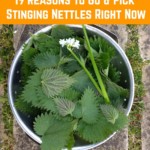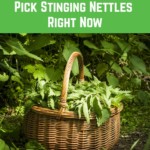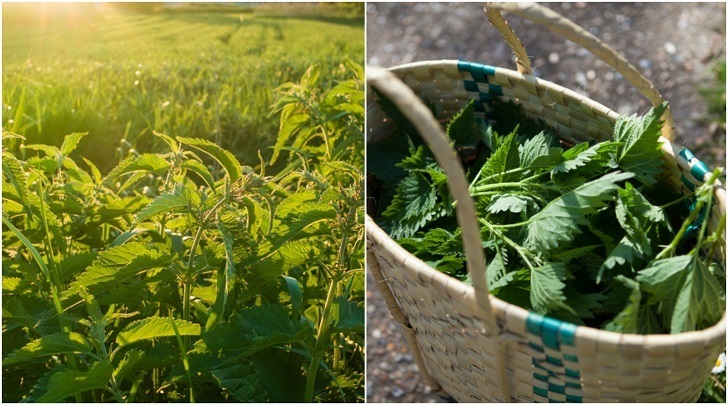
Let’s face it – nettles aren’t pretty, they pack a mean sting and they spread like wildfire. It’s no wonder that these weeds are the bane of most gardeners’ lives and are given wide berth when encountered on nature walks.
But there is much more to the nettle than meets the eye – they are one of the many backyard weeds that have extraordinary health benefits.
Learn all about the misunderstood stinging nettle, its health benefits and uses and why you should go out foraging for nettles right away. (Just make sure you have a really good pair of gardening gloves!)
Health Benefits of Stinging Nettles:
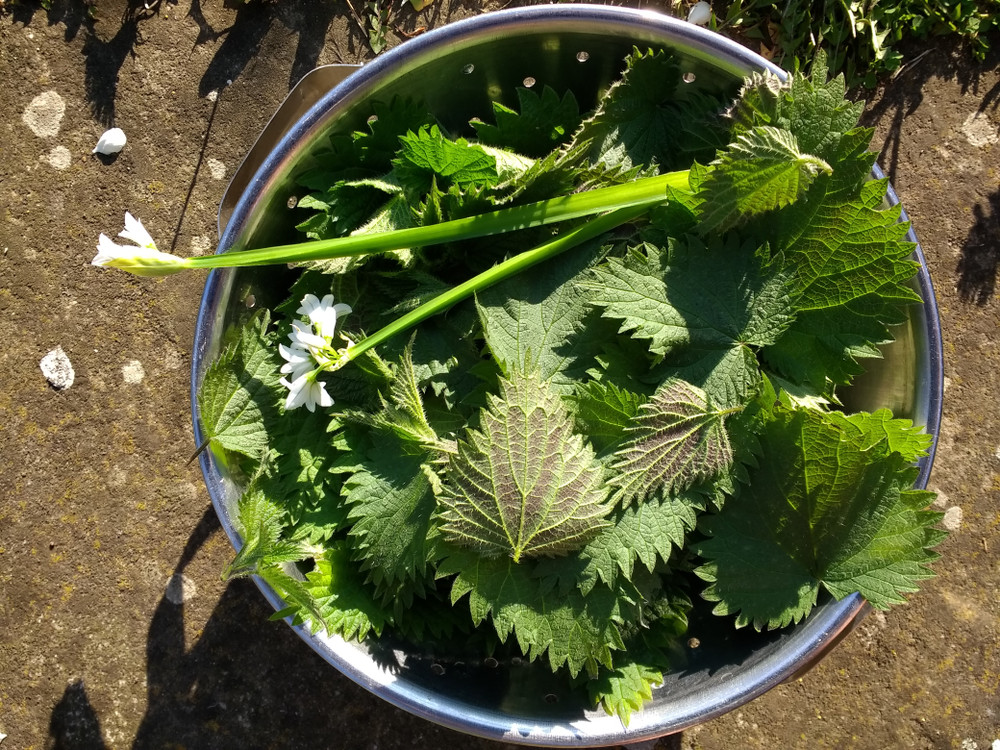
Nettles are rich in vitamins A, B2, C, D, and K and have important nutrients like antioxidants, amino acids and chlorophyll. They’re also a good source of calcium, potassium, iodine, manganese and iron.
These weeds have traditionally been used for urination problems and kidney stones, joint ailments and as a diuretic.
Other healthful properties of stinging nettle:
- Anti-inflammatory, analgesic, anti-rheumatic, anti-convulsant, antihistamine, astringent and hypotensive properties.
- Each cup of nettles supplies an impressive 1,790 IU of vitamin A, which is three times the recommended daily value.
- Treating anemia and fatigue due to a high iron and chlorophyll content.
- Reducing the pain associated with urinary tract infections (UTIs).
- Relief of arthritis, joint pain and gout when taken internally or used topically.
- Treating Benign Prostatic Hyperplasia (BPH) – a non-cancerous condition that causes the prostate gland to enlarge, making urination difficult.
- Reducing the symptoms of hay fever and allergies by acting as an anti-inflammatory. Some research has linked treatment with nettle leaf to relief of symptoms such as sneezing, runny nose and itchy eyes. In one study, 57% of patients rated nettles as effective in relieving allergies, and 48% said that nettles were more effective than allergy medications they had used previously.
- Nettle has been used for over 2,000 years to stop bleeding and it is considered to be a good blood purifier.
Picking Nettles:
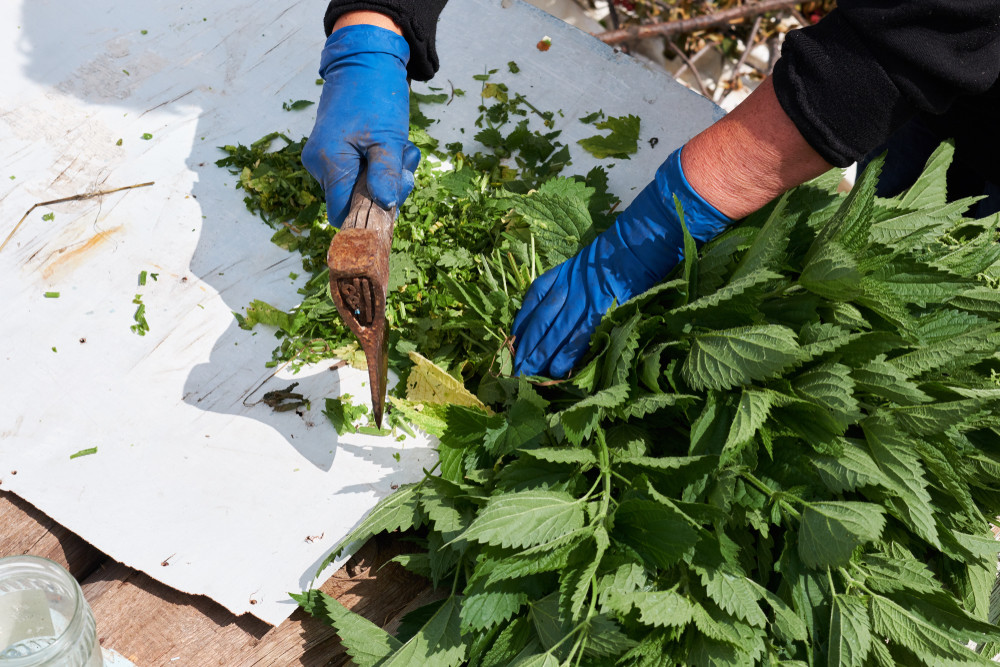
Gloves (such as this highly protective pair) are a must when picking stinging nettles. This video also shows you the correct technique to use. If you aren’t careful, you’re in for a nasty shock!
Tiny hollow hairs on the stems and underside of the leaves contain a mixture of chemicals – including histamine, acetylcholine, serotonin and formic acid. When you touch the leaves, they break and expose sharp points that inject your skin with these toxins. You’ll end up with itching, mild pain and inflammation.
If you do happen to get stung – an inevitable experience for most foragers and gardeners – apply a paste of baking soda and water to soothe and quell the inflammation.
Strangely though, when these chemicals come into contact with a painful area of the body, they can actually decrease the original pain. Scientists think nettle does this by reducing levels of inflammatory chemicals and by interfering with the way the body transmits pain signals.
How to Use Stinging Nettle:
In the Kitchen
Nettle leaves can be used in a variety of delicious dishes – your dinner guests will never know they are eating weeds! Keep in mind that nettle should first be cooked or steamed to destroy the chemical-containing hairs.
1. Stinging Nettle Pesto
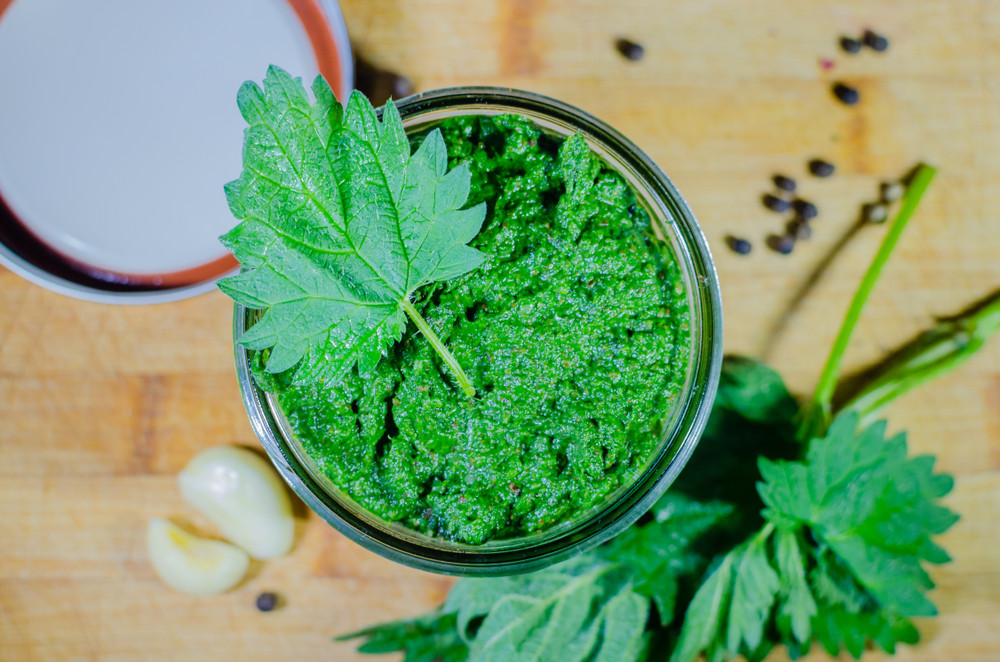
Nettles make for a beautiful pesto – more flavorful than the traditional basil variety, and a better match for pungent and earthy garlic. It’s delicious on pasta, bruschetta, or as a marinade for meats. You’ll find the recipe here.
2. Summer Soup
Perhaps the most traditional use of nettles in the kitchen, this soup recipe is ideal for those just dabbling with foraged food. It uses fresh nettles, potato, leek and cream for a velvety yet light summer soup. Here is the mouthwatering recipe.
3. Kimchi
While traditional Korean kimchi is a spicy and sour dish made with cabbage and various seasonings, this nettle-based version is a foraged take on a fermented favorite. Eat your way to good gut health by soaking nettles, herbs and spices in a brine solution – follow these instructions and you can’t go wrong.
4. Spinach and Nettle Crust-less Spanakopita
Traditional spanakopita is a Greek savory pastry made with chopped spinach, feta cheese, onions and dill. Swap some of the spinach out for nettles and enjoy added nutrition with no compromise on flavor. Follow Stitch and Boots’ recipe here.
5. Wild Herb and Nettle Risotto
A Mediterranean inspired dish, risotto is delicious and filling. This version is packed with both nutrients and flavor thanks to its long list of ingredients: nettles (of course); herbs like parsley, tarragon, chives, wild chervil, yellow rocket, and wild garlic leaves; shallots; butter; stock and white wine. Full details can be found here.
6. Nettle Fettuccine Alfredo
While making pasta from scratch isn’t for everyone, you should give it a go at least once. And what better recipe to get you started than this fresh green nettle pasta – so good it’s almost a superfood! Serve with cream and parmesan for an impressive and hearty Alfredo. This video and recipe makes it a cinch to whip up.
7. Nettle and Potato Curry
There’s something about potatoes in a curry that take it to the next level – double the comfort of a typical spicy meal. Well, this recipe delivers in terms of comfort, taste and nutrient density thanks to the addition of stinging nettles, herbs, spices, creamy yogurt and lime juice. Check it out here.
8. Garlic Cream & Nettle Pizza
For an artisanal pizza experience, pair the deep, earthy flavor of nettles with a delicious green garlic cream and lay it on top of a stone-baked, homemade dough. You’ll need green garlic, white wine, heavy cream, buffalo mozzarella, nettles and parmesan cheese to make this delight. Here’s what you need to do.
9. Nettle Frittata with Wild Spring Salad and Citrus Herb Dressing
To truly impress with foraged food, this is the recipe to serve. Enjoy a flavor explosion thanks to this dish’s use of garlic oil, fresh thyme, tarragon, a trio of citrus juices, onion and shallots, cheddar and parmesan, baby spinach, tender asparagus, juicy plum tomatoes, wild sorrel, and watercress. Sure, it requires some preparation but the results are worth it. The recipe can be found by clicking this link.
10. Nettle Berry Smoothie
Green smoothies can provide a wealth of benefits – from helping you reach your daily vegetable intake to losing those last few pounds, and from fighting inflammation to boosting energy.
Perhaps this smoothie even outranks all others in terms of nutrient density! As we’ve seen, stinging nettles are bursting with nutrients – but so too are the berries used here. In fact, berries are the most antioxidant rich fruit out there – and contain some of the lowest levels of sugar too. Here is the easy-to-make recipe.
11. Healing Tea
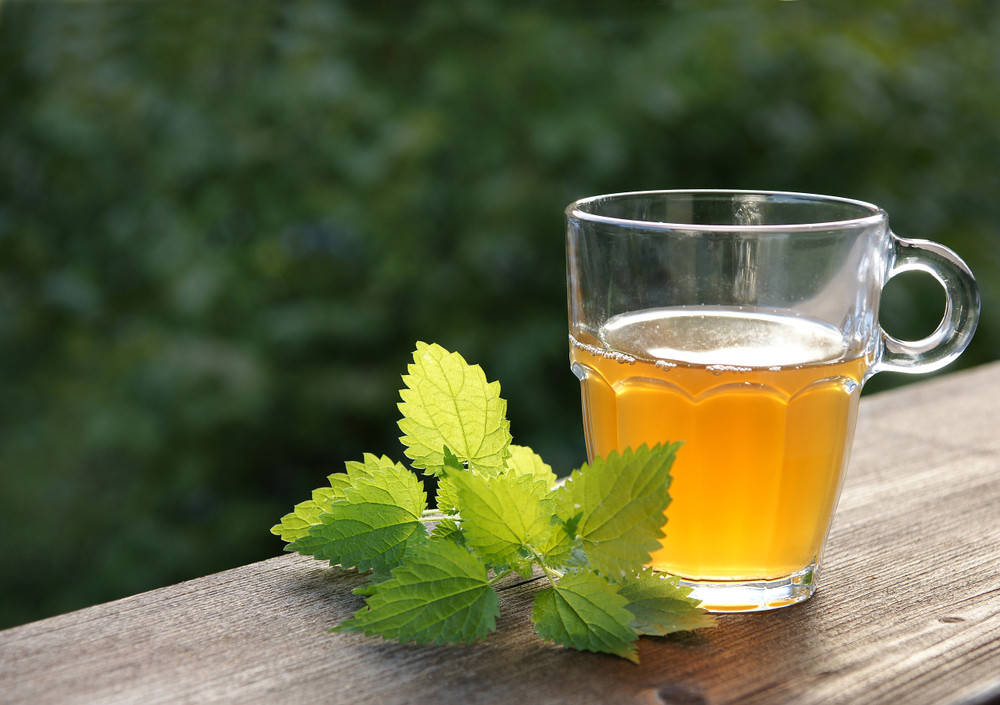
Nettle tea has been brewed for centuries due to its healing and healthful properties. This blend is made overnight – just add the plant to a mason jar and cover with hot water. Allow to cool before transferring to the fridge, where it can infuse until the next day.
Enjoy the tonic heated or iced, with or without sweetener to complement its ‘grassy’ flavor. The full details can be found here.
12. Hedgerow Beer
For a home brew with a difference, try out this foraged nettle beer. It’s simple to make, has a pleasant (although somewhat unsophisticated) flavor, and is quite the strong tipple. To make this unusual beer – sure to be a talking point at any gathering – you’ll need a large bag of nettle tops, sugar, lemons, cream of tartar, Irish moss and beer yeast. Here’s the step-by-step process for making a home brew from the hedgerow!
For Health and Beauty
Harness the healing power of nettles for aching joints, luscious locks and glowing skin. Your dog can even benefit from this common weed!
13. Nettle Oil
Nettle oil is usually extracted from the dried leaves of the plant and forms the basis of most of the medicinal and beauty uses of nettle. Because it contains chemicals (the same ones that sting you!) that alleviate pain by interfering with the way nerves send pain signals, it can help those who suffer from rheumatism, arthritis and osteoporosis. It is also used to heal skin abrasions and burns quickly and may even help with eczema and other skin conditions.
To make, fill a mason jar with fresh nettle leaves and stems. Cover with olive oil or coconut oil. Seal the jar and allow to rest on a sunny windowsill for up to three weeks, shaking daily. Once infused, strain the mixture through a cheesecloth and store the oil in a dark glass container, out of sunlight. Before use, dilute with a safe carrier oil.
14. Hair Growth Shampoo
Nettles can stimulate the growth of hair and control oil production, making them the perfect ingredient in shampoo. You can add a couple of drops of nettle oil to your own shampoo, or whip up a DIY version using nettle-infused water, Dr. Bronner’s liquid castile soap, jojoba or sweet almond oil, aloe vera juice and essential oils of your choice. Here is the full ‘how-to’ guide.
15. Hair Rinse
An alternative to stinging nettle shampoo is a simple nettle hair rinse. This gentle and safe herbal infusion can be used weekly to add shine, reduce oil and promote growth. It’s best used on those with brown or black hair though as it can darken blondes!
Simply add one ounce of dried nettle leaf in a quart glass canning jar and top with boiling water. Steep for two to four hours before using. As a bonus, you can also drink this – feeding your hair from the inside! Want to add a little something extra to your rinse? Here are some ideas for nourishing additions.
16. Nettle, Lime and Spearmint Soap
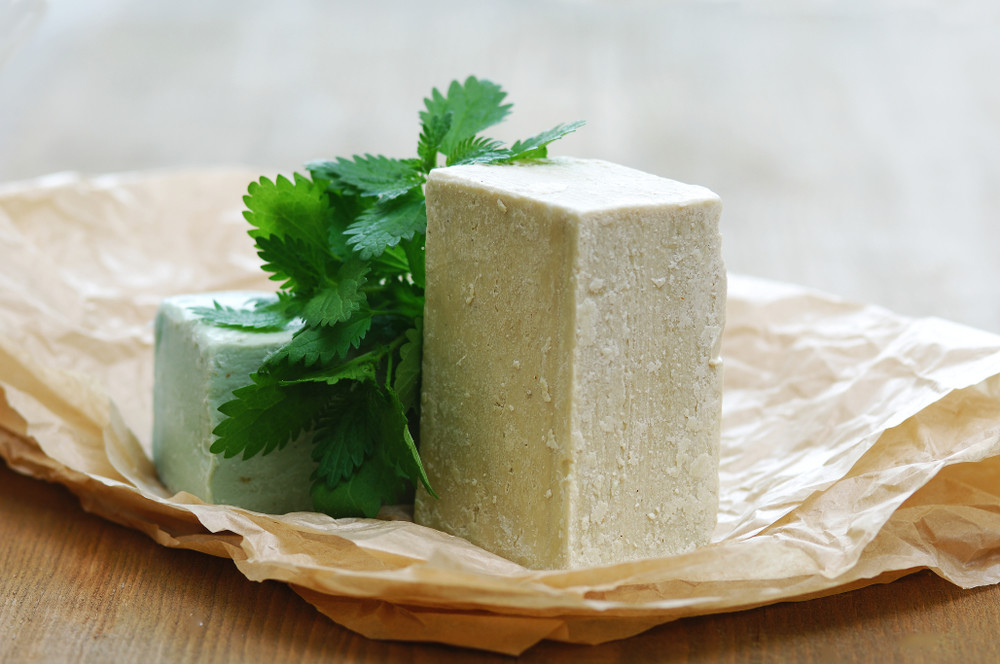
Powdered nettle leaf, dried nettle and natural lime and spearmint essential oils give this soap a clean, fresh aroma. It also has natural antiseptic properties, and contains coconut oil and Vitamin E – all of which combine to combat wrinkles, greasy skin, itching and acne. Learn how to make it here.
17. Massage Oil
To kill pain, nourish skin, treat skin conditions and reduce wrinkles, why not add a few drops of nettle oil to your homemade massage oil? Here are some fantastic DIY massage oil blends to get you started.
18. Dog’s Health
Your human family members aren’t the only ones who can benefit from nettle’s nutritive properties – your dog can too! Nettle is great for a dog’s digestion, energy levels, allergies, skin and coat.
To make a coat rinse (for dark-coated dogs only) add three tablespoons of dried nettle to two cups of boiling water and allow to cool. Strain this mixture and then work into the dog’s coat and skin after shampooing. Allow the dog to air-dry.
You can also sprinkle the dried herb onto your dog’s food (a half teaspoon per lb. of food).
In the Garden
Because stinging nettle is such a valuable plant, it’s best used as a food or medicine – but your garden can also benefit in at least one way!
19. Liquid Fertilizer
Liquid fertilizers, also known as ‘weed teas’ are simple to make and provide your fruits, vegetables and flowers with a hearty dose of much needed nutrients. Because nettles are so mineral rich, they can be especially useful when whipping up a fertilizing tea.
Nettle leaf plant food will have plenty of chlorophyll, nitrogen, iron, potassium, copper, zinc, magnesium, calcium and more. There are two ways to make nettle based tea – the slow way or the quick way (which produces subtler results). Both are detailed here.

